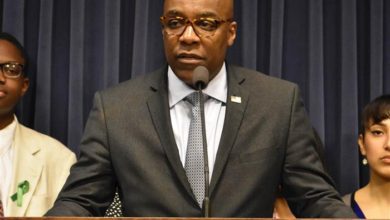Becoming an advocate for a child who has been abused: Murphy volunteers with CASA

Champaign County CASA is a not-for-profit organization that recruits, trains, and monitors volunteers who speak for the best interest of abused and neglected children. CASA will have the next volunteer training from April 16-May 8, 2019. If you are interested in giving your time to youth in our community with CASA, you can go to www.casa4kids.org for more information and to complete the application or contact Brooke Adams at 217-384-9065.
There are some situations in life when bystanders don’t know what to do.
Witnessing child abuse is often one of them.
But, in the middle of Child Abuse Awareness month, the Champaign County CASA (Court Appointed Special Advocate) wants bystanders to know that there are many things that can be done to prevent present and future abuse of children.
CASA is a national organization which recruits, trains, and monitors volunteers who advocate for the best interests of abused and neglected children.
In 1994, under the direction of Circuit Court Judge John R. DeLaMar, Champaign County established a CASA system so that children would have an advocate when life-altering decisions were being made on their behalf.
There are 22 CASA organizations throughout Illinois.
Currently, there are between 375 and 400 children in the Champaign County court system. Thirty-five percent of the children within the Champaign County court system are under the age of 6.
“We see cases for a variety of reasons, but the biggest reason is exposure to domestic violence and substance abuse by their caregiver and the effect that has on them in that environment,” CASA Program Administrator Brooke Adams said. “We do also have cases of physical and sexual abuse.”
Once the parents and children enter the court system, some of the children receive an advocate from CASA.
Not all of the children receive a volunteer advocate because, at this time, there are not enough volunteers.
Approximately 100 children within the Champaign County system have a CASA volunteer who visits monthly, appears in court, learns about their history and helps make sure they have the resources they need for the future.
While the other 275 children in the Champaign County Court system have the CASA organization checking in on them and making sure they have what they need, Urbana resident and CASA volunteer Candi Murphy believes there is a difference.
“It’s kind of like the difference between if you are sick and you go to convenient care,” she said. “You are going to see a trained professional, a person who has read the file, who knows how to ask the questions. That child’s needs are being met, we know about them.”
“When you have a primary care physician, they know you. They know your history, they know what questions to prod, they know if you are not doing well in school there is a chance that maybe something isn’t going well.”
“CASA is seeing all the kids and making sure all of their needs are met, but it’s so different between having a CASA volunteer who knows your case and having the CASA organization check in on your life.”
CASA volunteers commit to two years with the organization. The initial training takes 30 hours over 10 weeknights: Tuesday, Wednesday and Thursday.
After the initial training and becoming familiar with the case, a CASA volunteer, on average, spends four to 10 hours a month being an advocate for the child.
CASA only holds three training sessions a year. The spring session is scheduled to begin April 16.
Murphy decided to become a CASA volunteer shortly after retiring from teaching in the Mahomet-Seymour School District.
“I knew I wanted to stay active with kids,” Murphy said. “But I wasn’t quite sure what CASA was.
“Being a school teacher, I knew lives were messy and that parents were under a lot of stress, and I also knew that children didn’t function well when the family at home was very stressful.”
Murphy said that through her time as a volunteer, she has seen CASA on the front line of child abuse awareness and prevention.
“The first thing in preventing future abuse is to make sure that the kids when they come from a background of abuse or trauma, get the help and the services that they need,” she said.
Because the court system is set-up to restore the family, when possible, the court often provides a way for parents to get the resources they need.
“The parents have put the children in that situation, so, of course, the bulk of the attention and the services go to the parents. Their situation is what brought the case into care, their situation is what needs to get fixed,” Murphy said.
But when a child has been taken from their parents or home, it can be an unsettling time.
“We just kind of assuming because they’re no longer in that situation, they are fine,” Murphy said. “But they are not fine. Those children are not fine.”
CASA volunteers visit the children monthly, checking in with the foster home, the parents, teachers, caseworkers and anyone else associated with the child. The volunteers also make sure that the child is receiving the services or medication they need.
When a court appearance is scheduled, the volunteer, who knows about all the working components of the child’s environment speaks to the judge on behalf of the child.
“We’re being that voice based on our interactions with the child and our contact with other people in the case,” Adams said.
“We are the eyes, ears and voice of the child,” Murphy added.
Because the Department of Children and Family Services and social work caseloads are so large, Adams and Murphy said that many times, a child within the court system will be passed from caseworker to caseworker.
This is why a CASA is so important to the children.
“The CASA is the one constant in their life who promises to stick with them throughout the entirety of their case,” Murphy said.
The CASA volunteer, who understands the child’s history and the process the child has gone through to be placed in a stable and permanent environment, is what CASA refers to as “the one anchor in that child’s life,” Adams said.
“In a time of upheaval and uncertainty, a CASA is that one piece of stability that every month,” Murphy said. “It’s a real anchor and a cornerstone.”
Walking with children who have experienced a traumatic situation is enough for Murphy. But Murphy knows that the assistance she provides during the time the child is within the court system will last a lifetime.
“Being a CASA, I cannot change the past,” she said. “I cannot make it better for them. I cannot take a magic wand and undo it. But I know that every time I write a court report or when I advocate, I know that I’ve been able to change the path of that case.
“Maybe it’s going to close quickly and they can get back home to permanency and stability, maybe I can bring something to the awareness or some service that they need; so while I can’t change the past, I can make sure that they are getting everything that they need so that their future has a better outcome.”
A retired teacher, Murphy has also enjoyed the flexibility of being a CASA volunteer.
While CASA volunteers commit to keeping up with the child every month, there is flexibility within the schedule of when to meet with the child and the caretakers.
CASA volunteers are also given the freedom to chose how many cases, what types of cases and what age of children they would like to work with.
She has also found great support in the CASA system.
“If anytime if I am confused about something or unsure, I have a great working relationship with all the coordinators so I’m not in it alone,” she said.
Adams said that nearly all of the CASA volunteers used to be retired individuals, but the pool now consists of about 60-percent retired individuals and 40-percent with full-time jobs. Volunteers must also be over 21 and pass a background check.
“All of our volunteers are very dedicated; they give their time, they understand that this is a big responsibility speaking up for a child in court and making sure they get on the right path in a safe, permanent situation as fast as possible,” Adams said.
But Adams also said there are ways that community members can also be involved in preventing child abuse.
“Prevention for us is whenever we’re seeing a change in a child’s behavior or recognizing that a child is struggling and being able to somehow support them in some way so that it doesn’t come to the point where the child is abused or neglected,” she said.
Sometimes, she said, it’s just understanding that children sitting in a classroom have been through many different life circumstances.
“We just ask people to have an open mind in understanding of what’s going on,” she said.
Adults can also stand up for children by notifying the proper authorities when they believe a child is in a harmful situation.
“Children don’t have a way to let other people know the things that are going on in their lives,” Adams said. “So, if you, as an adult see something, don’t be afraid to talk about it; to let an authority figure know.”
Murphy said that notifying the system of potential abuse and neglect is sometimes a blessing in disguise.
“I think sometimes people are afraid to speak out because they are afraid of what is going to happen to the family, but I would say that family is in such a stressful situation, it’s almost a blessing in disguise,” she said.
“What shocked me is the judicial system. In my mind, I used to think that you would call and the parents would go to court and be punished.
“But the judicial system is restorative. The main goal when children come into services is to be reunited with their parents. The judge is very aware that the idea is to restore the family, so it’s not that they are going to punish the parent, it’s that this parent is in a situation where they need services. Once the court becomes aware of the situation, it’s ‘How do we fix this family’s situation?’”
The court works to get a parent who accepts help classes, counseling, tools or resources.
“The system is meant to restore the family,” Murphy said. “It’s not meant to punish the family.”
Adams said that through helping children who have been through abuse receive the care, role models and foundation they deserve, child abuse can become eradicated in some circumstances.
“There is a big cycle of abuse and neglect that stays within families,” Adams said. “We want to break that cycle. We want whatever generation we are working with to be the end of that.”
To become a CASA volunteer, contact Brooke Adams at badams@casa4kids.org or by calling (217) 384-9065.





